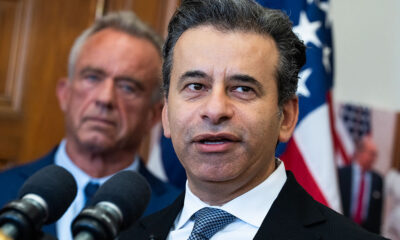Science
University of Utah Researcher Uses Dance to Explain Neurology

The University of Utah has highlighted the innovative approach of researcher Cheenu Raghuraman, who merges the art of dance with scientific research to enhance understanding of neurology. Raghuraman’s studies focus on the neurological mechanisms of fish, particularly how the venom of the cone snail impacts their proprioception, or spatial awareness. This unique intersection of science and performance art allows Raghuraman to communicate complex ideas in a relatable manner.
Exploring Proprioception Through Dance
In an interview with “Humans of the U”, Raghuraman described proprioception as the body’s ability to sense where limbs are in three-dimensional space. He provided a simple example: “If you close your eyes and put your fingers together above your head, you know exactly where the tips of your fingers are, right?” This foundational concept is essential to both his research and his passion for classical Indian dance, which requires precise control of movement and positioning.
Raghuraman believes that such artistic expressions can make scientific concepts more accessible. He takes his work beyond the confines of the laboratory, visiting schools to perform simple experiments. His goal is to “simplify—not dumb down” the science for diverse audiences. By stripping away jargon, he aims to communicate in ways that resonate with people, thereby enhancing public understanding of neurology.
Adapting to New Challenges
Adaptation has been a significant theme in Raghuraman’s career. He transitioned from Sastra Deemed University in South India to the University of Utah, where he faced both cultural and academic challenges. His first week in Utah was marked by a snowstorm, a stark contrast to his previous environment, which required him to quickly adjust to new surroundings and the complexities of marine biology.
Raghuraman’s work exemplifies the potential for creative communication in science. By integrating dance into his presentations, he not only engages his students but also fosters a deeper appreciation for the intricacies of neurological research. His innovative approach serves as a reminder of the importance of accessibility in science, encouraging a broader audience to connect with and understand vital scientific concepts.
Through his unique blend of art and science, Raghuraman continues to inspire both his students and the wider community, demonstrating that effective communication can bridge the gap between complex research and public understanding.
-

 Science1 week ago
Science1 week agoResearchers Challenge 200-Year-Old Physics Principle with Atomic Engines
-

 Politics1 week ago
Politics1 week agoNHP Foundation Secures Land for 158 Affordable Apartments in Denver
-

 Health1 week ago
Health1 week agoNeuroscientist Advocates for Flag Football Until Age 14
-

 Health1 week ago
Health1 week agoFDA Launches Fast-Track Review for Nine Innovative Therapies
-

 Lifestyle1 week ago
Lifestyle1 week agoLongtime Friends Face Heartbreak After Loss and Isolation
-

 Politics1 week ago
Politics1 week agoIsraeli Air Strikes in Lebanon Kill One, Wound Seven Amid Tensions
-

 World1 week ago
World1 week agoTroops to Enjoy Buffalo Chicken, Thai Curry in 2026 MREs
-

 Business1 week ago
Business1 week agoMaine Housing Inventory Surges to Post-Pandemic High
-

 Politics1 week ago
Politics1 week agoMassachusetts Lawmakers Resist Audit After Voter Mandate
-

 Top Stories1 week ago
Top Stories1 week agoUnforgettable Moments: The Best Victoria’s Secret Performances
-

 World1 week ago
World1 week agoGlobal Military Spending: Air Forces Ranked by Budget and Capability
-

 Business1 week ago
Business1 week agoSpirit Airlines Cuts Workforce with Furloughs for 365 Pilots









